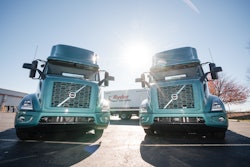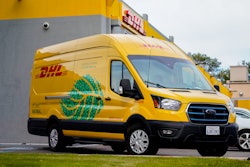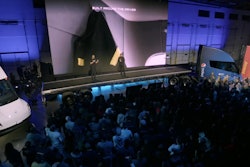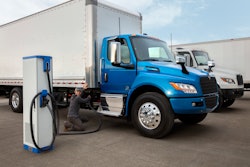Finding, much less securing, government-sponsored dollars is a cost-effective way for trucking fleets to begin the buildout of their EV network, but it's far from easy, noted Tad Glauthier, head of eMobility at Stem Inc.
Tad joins Matt and Jason on this week's 10-44 to talk EV incentives, how fleets can find them, and avoiding fraudsters in search of a quick buck at carriers' expense.
Contents of this video
00:00 Incentives for buying electric trucks03:38 Partners and suppliers
07:50 Finding charge management suppliers
08:30 The truck or the infrastructure?
11:38 Subsidies have accelerated adoption
Transcript
Jason Cannon
This week's 10-44 is brought to you by Chevron Delo 600 ADF ultra low ash diesel engine oil. It's time to kick some ash.
There's 2.8 billion on the table to boost EVs in the US, but how can fleets get a slice of that pie?
Hey everybody, and welcome back to the 10-44, a weekly webisode from the editors here at CCJ. I'm Jason Cannon, and my co-host, on the other side, is Matt Cole. When's the last time the government helped a fleet operator [00:00:30] offset the expenses associated with buying a truck or offered any kind of incentives to help fill it with fuel? This new post-pandemic reality that we're in, it's kind of weird, because that's exactly what's happened right now, depending on the kind of truck that a fleet's willing to buy.
Matt Cole
There are federal and state level incentives available for fleets interested in going electric, and those funds can be used to acquire the truck and the charging infrastructure needed to support them.
Jason Cannon
Tad Glauthier, whose Head of eMobility at Stem, Inc, says that knowing the money is out there is one thing, getting it [00:01:00] is another.
Tad Glauthier
We're looking at several different programs. There's a program called... Well, there's the IRA. That's going to really fuel the deployment of EVs, as well as more solar and storage. And so, that's kind of the most recent one that's getting a lot of press, and it's certainly one that we're excited about. Fleet operators can get tax credits up to $40,000 for fleet vehicles, up to 30% of the vehicles, so that's for [00:01:30] kind of larger last mile delivery vans on up to class A trucks. And they can also get 30% off the charging infrastructure that they build. A lot of fleet operators think about getting those vehicles first, and kind of the charging is an afterthought. And it turns out you really need to be thinking about, not just the cost of the charging infrastructure, but the timing of the charging infrastructure. Anybody placing an order for electric fleet vehicles today, you're probably looking at 12 months or more delivery timeframes.
It's going to take that long to build out your charging infrastructure for your fleet as well. So the Inflation Reduction Act really has a lot to offer for fleet operators on that respect, both for the vehicles and for that 30% off on the charging infrastructure. Another grant program is called the NEVI funds. And what the NEVI funds are for, the National Electric Vehicle Infrastructure Fund. And this is money coming, 5 billion dollars, coming out to the states, that's just starting to [00:02:30] hit in the form of RFPs. Every state's starting to run RFPs for owners of land right along the interstate highways and along transportation corridors, who want to build a charging site. And they might have an existing store or gas station or quick serve restaurant there or retail store.
But adding EV charging to that location will really make it more practical for everyday people, for consumers, as well as fleet operators, to go electric, because right now, there are huge stretches of the country that you really have to plan ahead if you're going to get across them with an electric vehicle. And we know that. We know we've got to get all this charging infrastructure built out, so that's where that 5 billion dollars coming out 1 billion a year, funneled into all 50 states, is hitting the states in December or January of this year. You you'll just start to see more and more landowners and developers starting to snatch up land along the highways and building out charging infrastructure. So I think [00:03:30] that's going to make as big a difference as bringing the cost down, in terms of the average consumer's willingness to go buy an EV.
Matt Cole
Working with the government isn't easy, especially when it comes to clearing all the hurdles and benchmarks that come with securing a grant. That's why Tad suggests finding suppliers that have the expertise and the willingness to handle some of the heavy lifting themselves.
Tad Glauthier
Somebody on the C level says, "Well, all you got to do is just go buy some electric trucks, instead of diesel trucks. What's so hard about that?" Well, [00:04:00] fleet operators are being asked to become energy experts as well. Now, there's a whole domain there around understanding utility tariffs. Your electricity bill becomes your fuel bill when you're in that position, and understanding what the other options are, which is distributed energy resources, is a great other option. You want to build solar and storage, for example, with your charging. That's one way to get your charging cost down.
So I recommend, and what we've tried to really promote to the industry is we're working with the charge management companies and presenting kind of a one stop shop offering. We've got two different partners, that we've announced partnerships with. We announced a partnership with ENGIE North America earlier this year, where, if a customer is doing a larger, more complex project, think of a couple million bucks, whole college campus or something [00:05:00] like that, or a number of sites in a region, and they want it financed and they want someone to build it all for them and manage all the government grants, ENGIE is fantastic at that.
They've got super program management capabilities, and we are bringing the software to manage the energy assets. But they're bringing that programmatic layer, that can implement everything and finance the whole thing. On the other side of the spectrum, we announced a partnership in September with a company called InCharge Energy. And InCharge Energy is a company that is purpose built to serve commercial fleet operators, everyone from small commercial fleets, with just a few vehicles, up to really large ones. InCharge has the engineering services to really design and install chargers for a customer, if that customer wants storage and solar.
So those clean energy resources are there to charge the vehicles. That's when InCharge will bring us in. And so, [00:06:00] their engineering group will design a whole site, and they'll work with us. And we will help figure out, what's the best mix of energy assets? Should you be pulling some from the grid and some from solar and storage? And really do all that work for a fleet operator up front. Say, "here's what your whole project's going to look like, and we'll implement it for you. Get your chargers, your solar, and your storage built out."
Jason Cannon
Government funding is ripe for fraud. You see it every time a hurricane makes landfall in a coastal state. Anybody with a hammer is suddenly a contractor, and once they have a handful of deposits, they're gone. Weeding through the network of energy companies, many of which are new, can seem kind of daunting, but Tad has some tips to share right after this word from 10-44 sponsor, Chevron Lubricants.
Protecting your diesel engine and its after treatment system has traditionally been a double edged sword. The same engine oil that is so essential to protecting your engine's internal parts is also responsible for 90% of the ash that is clogging up your DPF and upping your fuel and maintenance costs. Outdated industry thinking still sees a trade off between engine and emission system protection. And Chevron was tired of it, so they spent a decade of R&D, developing a no compromise formulation.
Chevron Lubricants developed a new ultra low ash diesel engine oil, that is specifically designed to combat DPF ash clogging. Delo 600 ADF with Omnimax technology cuts sulfate ash by a whopping 60%, which reduces the rate of DPF clogging and extends DPF service life by two and a half times. And just think what you can do with all the MPGs [00:07:30] you're going to add from cutting your number of regions, but Delo 600 ADF isn't just about after treatment. It provides complete protection, extending drain intervals by preventing oil breakdown. Before, you had to choose between protecting your engine or your after treatment system. And now, you don't. 600 ADF from Delo, with Omnimax technology, it's time to kick some ash.
Tad Glauthier
I think you've got to go and look at what their track record is. There's no substitute for experience. And in the EV charging world, there are companies that have been around for a few years. Not everybody's a startup that just got started this year and doesn't have a reference project to point to. Stem's been operating energy storage systems and distributed energy resources, storage, and solar, for over 10 years. InCharge Energy, you go look at their projects on their website. ENGIE North America, you go look at their projects on their website, and that's really how you get a comfort level that that company has done projects on the scale of your [00:08:30] project.
Matt Cole
The infrastructure or the truck is transportation's chicken or the egg conundrum, because you can't decide how many trucks you want until you confirm how much power the utility can supply. But you don't know how much power you'll need until you know how many trucks you're going to operate.
Tad Glauthier
That is really a tough one to crack, and it's a real problem. But there are solutions. I would start with, what trucks you can get, because the utility's going to want to know what you're asking for. And so, it is [00:09:00] a matter, first, of deciding, what are the routes you want to run? And what are the use cases? Are you running hub and spoke? Are you going over the road? And then, getting in touch with the OEMs, the manufacturers that have those trucks. There's a couple of great events every year, where you can actually do ride and drives, and I think that's really valuable, if one of those lines up, timing wise, and you're able to actually drive multiple trucks and compare them. There's a ride and drive, I think the next one's in April, at a show called ACTExpo. It's either late April or early May, and [00:09:30] you got to find the trucks that you can get on the timeline that you need them.
And then, I would go from there to one of these charge management providers, partners, that I mentioned, like InCharge, like ENGIE North America. And say, "here's the trucks I'm getting, what are my options?" And really starting the conversation with the utility at that time. If the utility says "we don't have as much power as you're looking for," it's usually not that they don't have that much power ever, it's that they don't have that much power right away. And so, you can look at [00:10:00] phasing strategies, bringing in some of your trucks that can be supported, and bringing a second phase in a couple of years later.
A lot of times, utilities are saying "it's a few years," and you can also look at solar and storage. So if you know you're going to have all your trucks and they need to charge in the same period of time, they're all out on the same duty cycle, out during the day, and they're coming back in the evening, and you want to get them all charged up in the same amount of time, so that your operators can go home, knowing the trucks are charged, that peak power, you only have that peak power need for a few hours.
You don't necessarily have that peak power need for 24 hours. And so, we can use batteries to help you meet that peak power need, that the utility may not have. And that's a real nice way to also justify the cost of a battery, which, over the long run, as your utilization goes up and as you get more and more trucks, and even if that power gets increased, that battery will switch over and start being used to help manage the utility bill. And so, you're avoiding the peak charges, avoiding the high time of use energy times from the utility, and serving that from the battery instead. So it's a great time to get in front of your utility early, but you do have to know what you're asking for to have that conversation. You've got a Fleet Depot right now, that maybe it's a parking lot, that doesn't have very much power, and it needs to have as much power as a football stadium or small town, by the time, you get all those class eights and you want to charge them all at your own hub.
Jason Cannon
Even though there are many government mandates in place that practically require fleets to go electric at some point, Tad says some of the subsidies definitely have accelerated adoption. And they're sorely needed, in both automotive and in trucking.
Tad Glauthier
The subsidies are absolutely accelerating adoption, and we do need them. We do need the subsidies to help bring the cost of an EV in line with the cost of an internal combustion engine vehicle. Right now, the majority of buyers, who are millennials and younger, want EVs, but it is skewed towards this demographic that doesn't have as much money to spend on a car as older people. So you do have a conundrum there, and those incentives will help the auto industry get to scale with the production of these new vehicles and setting up these new production lines. And that brings the cost down. We've been talking about grants. There's grant money coming in, all the way along the supply chain. There's grant money coming in from the Biden administration for 2.8 billion dollars, to get more battery materials mined and more battery manufacturing here in the US. That'll reduce supply chain disruptions and reduce the impact of trade and tariff issues on EVs. But that's going to take a couple of years for that to really happen.
Jason Cannon
That's it for this week's 10-44. You can read more on ccjdigital.com. And as always, you can find the 10-44 each week on CCJ's YouTube channel. And if you've got questions, comments, criticisms, or feedback, please hit us up at [email protected] or give us a call at 404-491-1380. And until next week, everybody stay safe.













